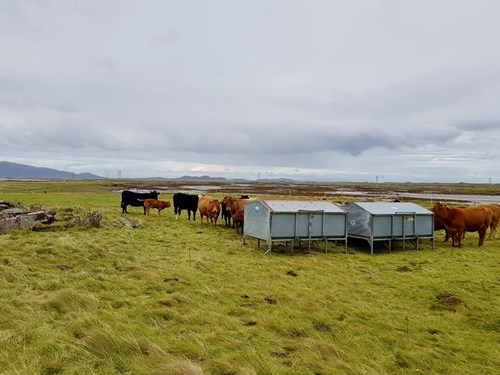Feeding the Suckled Calf

Getting the nutrition right of a suckled calf from birth is vital for future returns, both in the market and home bred replacements. The starting point is ensuring the calf receives good quality colostrum within the first two hours of birth, the calves ability to absorb the vital immunoglobulins significantly reduces over the first six hours of birth and has completely stopped by 24 hours. Initially, a calf has a similar digestive system to a monogastric with milk going straight into the abomasum, as the calf develops, it quickly becomes a ruminant.
Calves will gradually begin to nibble on forage and concentrates from as young as three weeks old, however it is not until they are about six to eight weeks old before they are able to consume and digest the feed properly. For autumn calves born inside, they should have access to a well-bedded separate creep area which allows the calves to lie down and eat away from their mothers.
Creep feed should be introduced slowly and gradually built up in quantity as the calves grow. By the time calves are four months olds, 50% of their nutritional requirements should come from grass, silage and/or creep feed. Feed conversion efficiency declines with age, therefore, young calves are very efficient at converting feed into liveweight. In older calves, the feed conversion ratio can be up to 4kg creep feed, which produces 1 kg liveweight gain.
The feed that is presented to calves needs to be palatable and fresh to encourage calves to begin eating. In terms of nutritional quality, an ideal creep feed will have a crude protein content of 16%, ideally 30% being bypass protein. Bypass protein is not broken down in the rumen by the microbes and passes through into the small intestine for digestion. Energy content should be 12.5 MJ ME/kg DM. Initially energy sources should come from digestible fibre sources such as sugar beet pulp, however as calves age, these sources can gradually move towards more starch-based energy.
The introduction of creep feeding in older, spring born calves can be beneficial for a variety of reasons. Introducing feed four to six weeks before weaning can reduce the stress associated with coming off their mothers, including drop in performance and pneumonia risk. In these calves, the feed will aid the transition and acclimatisation onto winter rations, which will allow the calves to maintain their performance during this time.
Feeding the suckled calf correctly and efficiently can see improved growth rates and reduced risks of a drop in performance following weaning. If you are considering introducing creep feed to calves, please speak to your nutritionist to discuss your options and how to utilise creep feeding to be cost-effective for your business.
Benefits of Creep Feeding
- Improved daily liveweight gains due to the high feed conversion efficiency.
- Growth targets met for calves being sold and replacement heifers.
- Reduced stress and performance at housing due to the calf being familiar with concentrate.
- Reduced pneumonia cases following housing.
- Speak to your nutritionist to discuss your options for creep feeding.
Dr Cara Campbell, Senior Consultant and Area Manager, Cara.Campbell@sac.co.uk

Unearthed is the exclusive SAC Consulting members' monthly newsletter. Unearthed offers insights and tips from our experts on what we think is in store for farming and crofting in the coming months in order to protect and enhance your business.
Posted by Unearthed News on 24/09/2024
